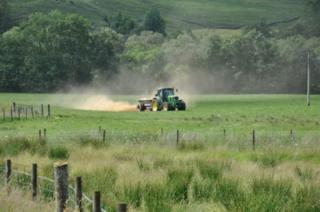Investigation Barriers to the Uptake of Nitrogen Use Efficiency in Scottish Agriculture
Published on 17 December 2013 in Climate, water and energy

Introduction
Nitrogen Use Efficiency (NUE) has been an explicit goal in agricultural policy for a number of decades. The Scottish Government recently proposed a target of a 90% voluntary uptake of the most cost-effective nitrogen efficient practices in order to enable the transition towards a low carbon economy. Uptake of NUE is also implicit in regulations aimed at improving water quality, such as the designation of Nitrate Vulnerable Zones, of which there are four in Scotland. Despite being seen as a ‘win-win’ measure there is still potential for increased uptake of NUE within the agricultural industry.
Encouraging uptake of NUE requires co-operative action across a number of levels within the agricultural and related industries. The supply chain for Nitrogen involves advisors from industry and the public sector, researchers, policy makers, regulators and the farmers themselves. Accordingly, an innovation systems (IS) approach, which assumes that technological transformation is the product of co-operation and alignment between all the actors within an innovation supply chain, was applied to begin to address the problem of low uptake of NUE.
The IS approach helps to identify barriers and potential solutions for the implementation of innovative practices.
Key Points
- Nitrogen use efficiency is a key pillar to achieving Scotland’s targets towards a sustainable low carbon economy.
- We use a multi-level approach, known as innovation systems analysis, to examine the problem of uptake and encourage dialogue between the major actors in the nitrogen supply chain.
- Creating voluntary uptake of Nitrogen use efficiency measures requires co-operation amongst all players within the nitrogen innovation chain, such as regulators, farmers and researchers.
Research Undertaken
SRUC’s Innovation and Behavioural change team are currently applying the IS approach to address a number of problems within various agricultural sectors. A workshop was held at SRUC in October 2013, with 15 participants representing government, researchers, regulators, and NGOs, such as SNH and the Soil Association, as well as representatives of the farming community.
Following a pre-defined structure this firstly mapped the innovation network for nitrogen usage, identifies the barriers and blockages to uptake within this network, and then finally uses these as tools to identify solutions. The data from the workshop was transcribed and coded to create a matrix of key barriers and solutions and a network analysis conducted of the innovation chain. These are used to describe the situation at the national level, and act as scoping tools. Further work will be carried out within individual businesses to investigate perspectives of the key actors, such as farmers and policy makers.
Policy Implications
There is a need to raise farmer awareness of the environmental issues related to nitrogen inefficiency: Many of the barriers are related to the difficulties farmers experience when engaging with new practices, or that advisors have in engaging with reluctant farmers with little free time.
Exploring alternative modes of communication and knowledge transfer is important. Such alternatives could include:
- Targeting non-farming groups such as wider rural communities and other users such as salmon fisheries to explore possible pollution sharing or raising issues of environmental conflicts.
- A ‘Back to basics’ approach such as awareness raising and education, as demonstrated by Farming for a Better Climate, and the Soil Association Facing the Future programme.
- Reports from monitoring programmes could be streamlined and fed back to farms in the appropriate format so that data is both useful and accessible.
Develop farm waste management planning further: There are a number of programmes, which have been effective in helping farmers identify and utilise their farm resources, and manage waste more efficiently. Rolling these programmes out to a wider group may overcome a significant behavioural barrier.
Training for software and demonstrating ease of use: Software such as PLANET is designed to help reduce the burden of adopting NUE practices, and can be simple to use given the correct training.
Knowledge exchange should focus on changing habits: This will require a number of actions, such as providing simple and clear messages, including: structured advice from collaborative efforts across organisations, and increased engagement through farmer networks and demonstrations.
The role for one-to-one advice should be prioritised as this raises confidence to encourage future group participation and takes into account specific farm conditions.
In order for NUE to become more of a priority there needs to be an increased awareness of the consequences of failure to adopt new practices. This should emphasise both short term and long term impacts.
There is also a role for what can be referred to as ‘better’ regulation. That is, offering more targeted subsidies, for example to help with drainage and storage infrastructure, and nitrogen related policies.
Authors
Dr Fiona Borthwick, SRUC Fiona.Borthwick@sruc.ac.uk
Dr Andrew Barnes, SRUC Andrew.Barnes@sruc.ac.uk





